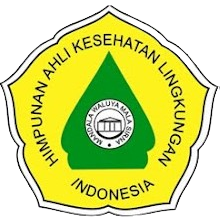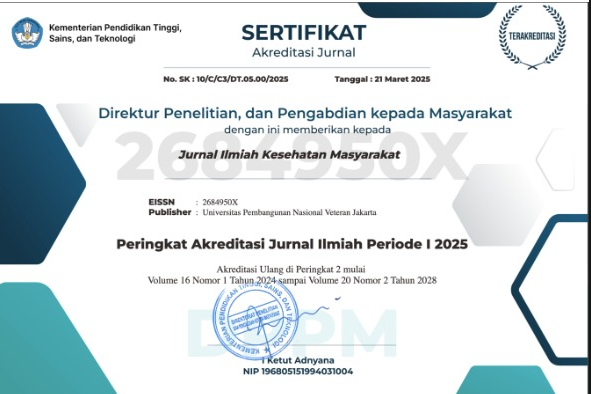Pajanan Pestisida terhadap Dermatitis pada Petani Perkebunan di Kota Depok
Abstract
Latar belakang: Prevalensi nasional kasus dermatitis di Indonesia adalah 6,8%. Dampak dari penggunaan pestisida terhadap kesehatan petani yang menerapkan pestisida terbanyak iritasi kulit sebesar 32,95%. Penelitian ini bertujukan untuk mengetahui hubungan penggunaan pestisida dan faktor-faktor lain dengan dermatitis kontak pada petani buah di Kota Depok.
Metode: Desain studi yang digunakan adalah cross sectional dilakukan antara bulan April-Juni 2018 dengan uji cox regression untuk mencari hubungan dan risiko pada tiap variabel. Sampel sebanyak 82 orang yang dipilih dengan teknik purposive sampling dan diwawancara menggunakan kuesioner terstruktur.
Hasil: Ditemukan 81,7% petani buah mengalami dermatitis. Golongan pestisida yang paling banyak digunakan adalah organofosfat, dengan durasi terpajan tertinggi ≥144jam/tahun sebanyak 47 orang (57,3%), frekuensi pajanan ≥2 kali/minggu pada 74 orang (90,2%) dan volume pestisida terbanyak ≥3600L/musim pada 44 orang atau 53,7%. Terlihat adanya risiko antara frekuensi terpajan (PR=5,20; 95% CI 0,68-39,38), dan volume pestisida (PR=2,12; 95% CI 0,52-8,65) dengan dermatitis kontak. Namun, tidak terlihat risiko yang jelas antara golongan pestisida (PR=0,42; 95% CI 0,10-1,80), durasi terpajan (PR=0,64; 0,15-2,57) dengan dermatitis kontak.
Kesimpulan: Studi ini menemukan adanya risiko pada frekuensi pajanan dan volume pestisida terhadap dermatitis kontak, tetapi tidak ditemukan adanya risiko yang jelas pada golongan pestisida dan durasi terpajan.
Kata Kunci: Dermatitis, pestisida, petani buah, organofosfat
Organophosphate Pesticides Exposure to Dermatitis in Fruit Farmers in Depok City
Background: The national prevalence of dermatitis cases in Indonesia is 6.8%. The impact of the use of pesticides on the health of farmers who apply the most pesticides of skin irritation is 32.95%. This study was aimed to determine the relationship between the use of pesticides and other factors with contact dermatitis in fruit farmers in Depok City.
Method: The study design used is cross sectional carried out between April-June 2018 and the Cox Regression test to find relationships and risks in each variable. The sample of 82 people was chosen by purposive sampling technique and interviewed using a structured questionnaire.
Results: It was found that 81.7% of fruit farmers had dermatitis. The most widely used pesticides were organophosphates, with the highest duration of exposure ≥144 hours/year for 47 people (57.3%), the frequency of exposure ≥2 times/week for 74 people (90.2%) and the highest volume of pesticides ≥3600L/ season on 44 people or 53.7%. This study found risk between the frequency of exposure (PR=5.20; 95% CI 0.68-39.38), and the volume of pesticides (PR=2.12; 95% CI 0.52-8.65) with contact dermatitis. However, there was no clear risk between pesticide groups (PR=0.42; 95% CI 0.10-1.80), duration of exposure (PR=0.64; 0.15-2.57) and contact dermatitis.
Conclusion: This study found a risk for contact dermatitis with pesticide exposure frequency and volume, but no clear risk for pesticide class and duration of exposure.
Keywords: dermatitis, fruit farmers, pesticides, organophosphates.
References
Spiewak R. Pesticide as a Cause of Occupational Skin Disease in Farmers. Ann Agric Env Med. 2001;(8):119–22.
Holness DL. Occupational skin allergies: Testing and treatment (the case of occupational allergic contact dermatitis) topical collection on occupational allergies. Curr Allergy Asthma Rep. 2014;14(2).
Nurcandra F, Mahkota R, Shivalli S. Effect of Personal Protective Equipment During Pesticide Application to Neurological Symptoms in Farmers in Purworejo District, Indonesia. Kesmas J Kesehat Masy Nas [Internet]. 2018;12(4):165–71. Available from: https://www.neliti.com/id/publications/261134/effect-of-personal-protective-equipment-during-pesticide-application-to-neurolog
Bhatia R, Sharma VK. The menace of dermatophytosis in India: The evidence that we need. Indian J Dermatol Venereol Leprol. 2018;84(1):6–15.
Song H-S, Ryou H. Compensation for Occupational Skin Diseases. J Korean Med Sci. 2014;29(Suppl):S52–S58.
Febriana SA, Jungbauer F, Soebono H, Coenraads PJ. Inventory of the chemicals and the exposure of the workers’ skin to these at two leather factories in Indonesia. Int Arch Occup Environ Health. 2012;85(5):517–26.
Febriana SA, Soebono H, Coenraads PJ. Occupational skin hazards and prevalence of occupational skin diseases in shoe manufacturing workers in indonesia. Int Arch Occup Environ Health. 2014;87(2):185–94.
Kiptiyah M, Wahyuni D. The relation between H2SO4content on latex and irritant contact dermatitis on workers in plantation area company of sumber tenggulun Jember. J Phys Conf Ser. 2021;1832(1):1–11.
Kementrian Kesehatan. Profil Kesehatan Indonesia Tahun 2013. Jakarta: Kementerian Kesehatan RI. 2014. 507 p.
Dinkes Depok. Profil Kesehatan Kota Depok 2015. Depok; 2016.
Rothman KJ, Greenland S, Lash TL. Modern Epidemiology. Vol. 63, Postgraduate Medical Journal. 1987. 418–419 p.
Jintana S, Sming K, Krongtong Y, Thanyachai S. Cholinesterase activity, pesticide exposure and health impact in a population exposed to organophosphates. Vol. 82, International Archives of Occupational and Environmental Health. 2009. 833–842 p.
Chakraborty S, Mukherjee S, Roychoudhury S, Siddique S, Lahiri T, Ray MR. Chronic exposures to cholinesterase-inhibiting pesticides adversely affect respiratory health of agricultural workers in India. J Occup Health. 2009;51(6):488–97.
Rahman DA, Zakianis, Fitria L. Pesticide Exposure , Behavior of Farmer , and Activity of Cholinesterase Enzyme in Blood of Fertile Women Farmers. J Kesehat Masy Nas. 2015;Vol. 10(2):51–6.
Sulistomo HSAB. Hubungan antara Pajanan Pestisida Organofosfat dengan Dermatitis Kontak pada Petani Sayur di Kecamatan Lembang. Depok; 2003.
Fareed M, Pathak MK, Bihari V, Kamal R, Srivastava AK, Kesavachandran CN. Adverse Respiratory Health and Hematological Alterations among Agricultural Workers Occupationally Exposed to Organophosphate Pesticides: A Cross-Sectional Study in North India. PLoS One. 2013;8(7):1–10.
Djuanda A. Ilmu Penyakit Kulit dan Kelamin Edisi Kelima. 3rd ed. Jakarta: Fakultas Kedokteran Universitas Indonesia; 2007.
Afifah RA. Afifah, R. A. 2014. ‘Hubungan Lama Pajanan Pestisida Terhadap Aktivitas Enzim Kolinesterase Darah Serta Gejala Gangguan Saraf Dan Kulit Pada Pekerja Tani ( Studi Pada Petani Dan Buruh Tani Di Kecamatan Kersana Kabupaten Brebes Jawa Tengah Tahun 2014. Depok; 2014.
Agius R. Practical Occupational Medicine. 2004.
Nuraga, Lestari F, Kurniawidjaja LM. Dermatitis Kontak Pada Pekerja yang Terpajan dengan Bahan Kimia di Perusahaan Industri Otomotif Kawasan Industri Cibitung Jawa Barat. Makara Kesehat. 2008;12(2):63–9.
Hasyim H. Analisis Hubungan Karakter Petani Kopi TerhadapPendapatan (Studi Kasus Desa Dolok Saribu Kecamatan Paguruan Kabupaten Tapanuli Utara). J Komun Penelit. 2006;
Ntow WJ. The use and fate of pesticides in vegetable-based agroecosystems in Ghana. 2008.
Abu Sham’a F, Skogstad M, Nijem K, Bjertness E, Kristensen P. Lung function and respiratory symptoms in male Palestinian farmers. Arch Environ Occup Health. 2010;65(4):191–200.
Nurcandra F. Association of Pesticide Aerosol to Lung Function Decline in Farmers in Purworejo 2016. Universitas Indonesia; 2016.
Rothman KJ. Epidemiology, An Introduction. 2nd ed. New York: Oxford University Press, Inc.; 2012.
Gordis L. Epidemiology. Canada: Elsevier; 2004.









.jpg)








